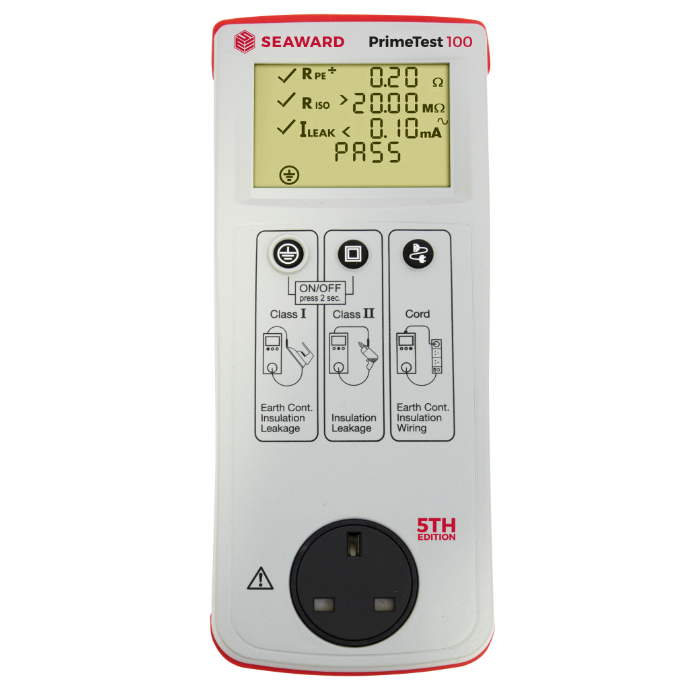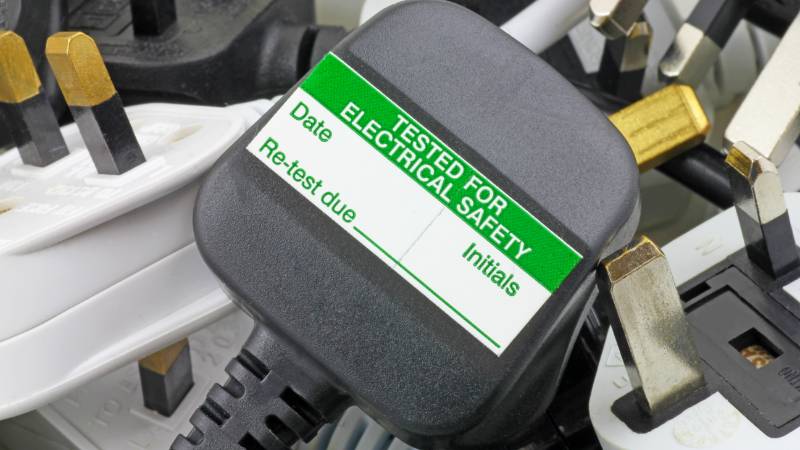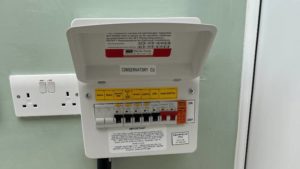What is PAT (Portable Appliance Testing)?
PAT testing, also known as Portable Appliance Testing or In-service inspection and testing of electrical equipment is the process of examining electrical appliances and equipment to ensure they are safe to use. It involves visual inspections and, in some cases, more detailed testing to check for electrical faults. PAT aims to prevent electrical accidents in the workplace or other environments where people use portable electrical equipment. This type of testing is an important part of workplace health and safety protocols.
Is PAT testing a legal requirement?
While there is no specific legal requirement in the UK for PAT (Portable Appliance Testing) to be carried out, the law does require that employers maintain electrical equipment to ensure it is safe to use. Regulations such as the Electricity at Work Regulations 1989 and the Health and Safety at Work Act 1974 mandate that employers take steps to prevent the risk of injury from electricity in the workplace. PAT testing is a widely recognized and effective method to fulfil these legal obligations by ensuring that electrical appliances are safe and not posing a risk to users.
How often should PAT testing be carried out?
The frequency of PAT (Portable Appliance Testing) depends on several factors, including the type of equipment, how frequently it is used, and the environment in which it operates. Below is a table of PAT testing frequency requirements for different settings in line with HSG107 by the Health and Safety Executive.
PAT Testing Requirements for Different Settings
Offices, Shops, Hotels:
- Class 1 Equipment (e.g., General IT Equipment): Test every 4 years.
- Portable Equipment (e.g., Extension Leads): Test every 2 years.
- Handheld Equipment and items used/transported frequently: Test annually due to higher damage risk.
Schools:
- Class 1 and IT Equipment: Annual testing.
- Class 2 Equipment: Test every 2 years.
Construction Sites:
- All 110V Equipment: Test every 3 months due to regular use.
Industrial Environments (including Commercial Kitchens):
- Portable and Handheld Equipment: Test every 6 months.
- Stationary, Movable, or IT Equipment: Recommended annual testing.
Rental Properties:
- Testing frequency for rental properties varies; however, it is often recommended to perform PAT testing annually, especially for frequently used portable appliances.
How much is PAT testing?
The cost of PAT (Portable Appliance Testing) can vary depending on several factors, including the number of appliances to be tested, the location of the premises, the complexity of the testing, and the service provider. Typically, there may be a base call-out charge and a per-appliance fee. For a small number of appliances, it could be relatively inexpensive, but for larger businesses with many items to test, the cost will be higher. Typically an hourly rate for a PAT tester is £35 to £55 an hour, or £1.25 per item.

Get in touch with the Martin Cook Electrical Services team today and request your free, no-obligation quotation. Have any questions? We’re here to help with any of your queries.
What is Class 1 and Class 2 in PAT testing?
In PAT (Portable Appliance Testing), ‘electrical classes’ refer to the categorization of electrical appliances based on their design and the level of protection they offer against electric shock. The main classes are:
Class I: These appliances have basic insulation and rely on an earth connection for safety. They usually have metal cases. The earth wire is essential for preventing electric shock.
Class II: Also known as ‘Double Insulated’ appliances, they do not rely on an earth connection for safety and have two layers of insulation. These are typically plastic-bodied appliances.
Class III: These appliances are low voltage (operating at a voltage normally not exceeding 50V AC) and are considered very safe. They usually use a transformer to reduce the voltage from the mains supply.
Understanding these classes helps determine the type of PAT testing required for each appliance.
What does Portable Appliance Testing involve?
Portable Appliance Testing (PAT) involves a series of inspections and tests on electrical appliances to ensure they are safe to use. The process typically includes:
Visual Inspection: Checking for any physical signs of damage, such as frayed cords, damaged plugs, or loose parts.
Earth Continuity Testing: For Class I appliances, ensuring the earth connection is effective.
Insulation Resistance Testing: Ensuring the insulation is intact to prevent electric shocks.
Functional Checks: Verifying the appliance operates correctly.
Additional Tests: Depending on the appliance, further tests like polarity check, earth leakage test, or load test may be conducted.
After testing, each appliance is usually labelled with a pass or fail sticker, and a record is kept for compliance purposes.
Do I receive a certificate for PAT testing?
After completing Portable Appliance Testing (PAT), you should receive a certificate or a report. This document provides a record of the testing performed, including details of each appliance tested, the tests carried out, and the results (pass or fail). It serves as proof of compliance with safety regulations and is important for record-keeping, especially in a workplace environment.

How long is a PAT test valid for?
The validity of a PAT test varies based on the type of appliance, its use, and the environment it’s in. Generally, the validity can range from three months to one year for heavily used equipment in high-risk environments to up to four years for less frequently used or lower-risk appliances. However, it’s important to regularly assess the risk and determine appropriate testing intervals for each appliance.
How often do landlords need to do PAT testing?
The frequency of PAT testing for landlords is not legally specified, but it’s generally recommended to perform it regularly for safety. Common practice is to conduct PAT testing annually, especially for high-use or portable appliances in common areas. For appliances provided in rental properties, testing between tenancies or every 12 months is a prudent approach to ensure tenant safety and compliance with general electrical safety obligations.
Do washing machines need pat testing?
Yes, washing machines in rental properties or used in commercial settings like laundromats should undergo PAT (Portable Appliance Testing). This ensures they are safe to use and comply with electrical safety standards. For landlords, this is part of ensuring the safety of electrical appliances provided to tenants.
Do phone chargers need PAT testing?
Yes, phone chargers should ideally undergo PAT testing, especially in environments like workplaces, public spaces, or rental properties where they are provided for use by different people. This is to ensure their safety and functionality. Regular testing helps in identifying and mitigating any risks associated with electrical faults.
Do hand dryers need pat testing?
Yes, hand dryers, especially those in public or commercial spaces, should ideally undergo PAT (Portable Appliance Testing). Regular testing ensures they are safe to use and function correctly. It’s part of maintaining electrical safety standards in such environments. Hand dryers must be tested as part of Portable Appliance Testing (PAT) as it is sometimes assumed that they are tested as part of an Electrical Installation Condition Report which is not correct.

Get in touch with the Martin Cook Electrical Services team today and request your free, no-obligation quotation. Have any questions? We’re here to help with any of your queries.
Who can perform PAT testing?
PAT (Portable Appliance Testing) can be performed by a competent person who has the necessary skills, knowledge, and experience to undertake the testing. This could be an in-house trained staff member or a professional external contractor. The person conducting PAT should understand the types of appliances that need testing, be familiar with the testing process, and be able to interpret the results accurately. They should also have undergone appropriate training in PAT testing procedures and the use of PAT testing equipment.
What items typically get PAT tested?
Typical items that get PAT tested include a wide range of portable electrical appliances such as: Kitchen appliances like kettles, microwaves, and toasters, Office equipment like computers, printers, and photocopiers, Power tools and equipment used in workshops, Extension leads and power strips, Portable heaters and fans, Audio and visual equipment including TVs and projectors, and Chargers for phones and laptops.
Any electrical appliance that can be moved and is not part of the permanent wiring of a building is subject to PAT testing.
How long does PAT testing take?
The duration of PAT (Portable Appliance Testing) can vary depending on the number of appliances to be tested and their complexity. Testing a single appliance might take only a few minutes, but in a setting with multiple devices, such as an office or a commercial property, the process can take several hours or even a full day. The overall time also depends on the ease of access to the appliances and any necessary preparations for safe testing.
Get in touch with Martin Cook Electrical for your free, no-obligation PAT testing quote here.




